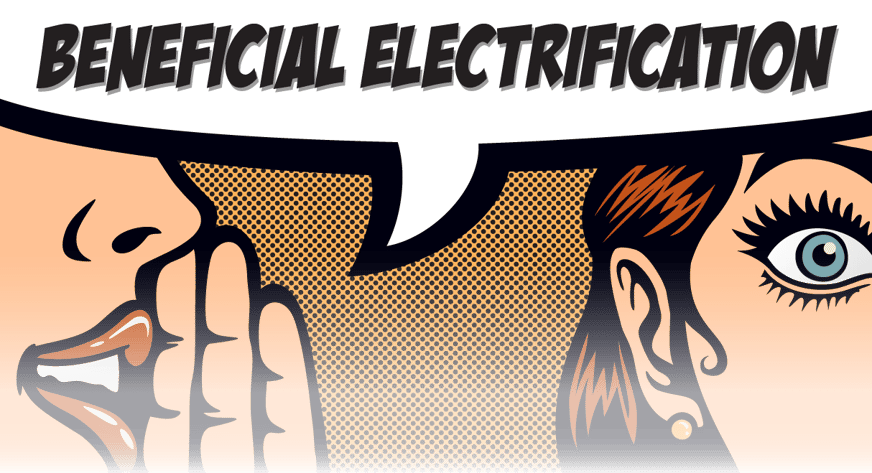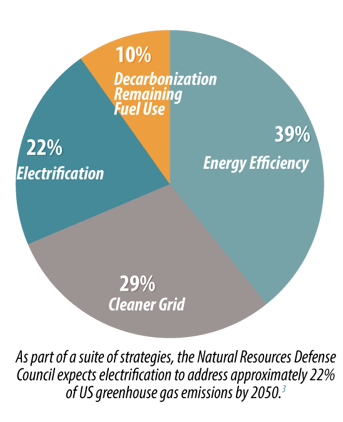- Home
- Services
- Hi-Line Engineering
- About
- Careers
- Contact
- Requests For Proposals
Beneficial Electrification
by GDS Associates, Inc | August 20, 2020 | Newsletter - TransActions
 Beneficial Electrification is getting a lot of buzz. Is that the sound of humming transformers? The fan on a heat pump? This article introduces the topic with deeper dives into beneficial electrification policies, programs, and technologies in future articles. But before we go too far, let’s get down to the basics. What is beneficial electrification?
Beneficial Electrification is getting a lot of buzz. Is that the sound of humming transformers? The fan on a heat pump? This article introduces the topic with deeper dives into beneficial electrification policies, programs, and technologies in future articles. But before we go too far, let’s get down to the basics. What is beneficial electrification?
The Beneficial Electrification League, a non-profit founded by the National Rural Electric Cooperative Association (NRECA) and the Natural Resources Defense Council (NRDC) to promote beneficial electrification, defines it as “the application of electricity to end-uses where doing so satisfies at least one of the following conditions, without adversely affecting the others:
- Saves consumers money over time
- Benefits the environment and reduces greenhouse gas emissions
- Improves the product quality or consumer quality of life
- Fosters a more robust and resilient grid.”¹
In response to concerns over climate change, electricity supplies with lower carbon emissions, and challenges with finding carbon-neutral alternatives to natural gas, propane, and other fossil fuels, beneficial
electrification is viewed by many as a key opportunity to cost-effectively address climate change.
 Beneficial electrification can touch on nearly any energy using end-use that consumes fossil fuels. This includes buildings and their needs for space heating or cooling, water heating, or cooking. It can also include industrial or agricultural processes, on-road or non-road electric vehicles or facility support equipment, such as electric forklifts. The load growth opportunity that beneficial electrification can offer electric utilities is obvious. But that load growth could pose risks to peak demand or local infrastructure near its capacity. The good news is that grid resiliency is a core concept of beneficial electrification and a tool that can be used to drive utility programs or offer customers new services. From direct load control to rate design, planning for beneficial electrification can lead to innovation and become a method to drive positive customer marketing and engagement.
Beneficial electrification can touch on nearly any energy using end-use that consumes fossil fuels. This includes buildings and their needs for space heating or cooling, water heating, or cooking. It can also include industrial or agricultural processes, on-road or non-road electric vehicles or facility support equipment, such as electric forklifts. The load growth opportunity that beneficial electrification can offer electric utilities is obvious. But that load growth could pose risks to peak demand or local infrastructure near its capacity. The good news is that grid resiliency is a core concept of beneficial electrification and a tool that can be used to drive utility programs or offer customers new services. From direct load control to rate design, planning for beneficial electrification can lead to innovation and become a method to drive positive customer marketing and engagement.
TRANSPORTATION
As we all know, electric vehicles are moving from being an exotic oddity to a more mainstream option. Driven by innovations in battery technology, electric vehicles, stationary battery storage, and control
systems are opening new markets for electric utilities. These innovations create unique challenges with grid and charging options, in particular for the DC fast charging efforts that may require transformer
upgrades, scheduled charging windows, or even additional planning staff. Utilities, local governments, and others are working to help plan the best ways to expand the market, pay for assets, manage growth,
and manage electricity loads.
There are also opportunities for beneficial electrification in the non-road, off-road, and medium/heavy duty transportation sector, providing operational and economic benefits over their liquid counterparts. Non-road electrification offers value beyond energy – fuel price stability, health and safety, reducing environmental emissions, improved performance and convenience are driving adoptions and innovation in the trucking, industrial yard equipment, transportation center, and manufacturing segments. These market segments may drive rapid changes in loads due to the scale of their operations. Whether across a market segment or at a single facility, the scale of adoption and loads can create a substantial impact. For example, electrified ship to shore cranes at port-based cities offers customers more rapid freight offloading, but also relies on very large motors likely to operate during peak time periods. 
BUILDINGS
Opportunities in the building sector have substantially improved over the last decade. Cold climate heat pumps – high efficiency heat pumps that can maintain capacity in cold weather are a key opportunity for regions that have high heating demands. Heat pump manufacturers are now offering integrated controls that allow for optimizing dual fuel systems in which a building’s legacy fossil fuel system is retained for use in the coldest weather, with the heat pump taking on the dominant heating role. The efficiency gains for space cooling by using these high efficiency heat pumps are substantial – seasonal energy efficiency ratios of over 20 are common,  far above the minimum federal standard of 14, creating an opportunity to create cooling energy and demand savings during the summer while providing efficient heat in the winter. Variable refrigerant flow systems are available for larger commercial buildings, while very efficient ground source heat pumps can meet the needs of small buildings up to large campus facilities.
far above the minimum federal standard of 14, creating an opportunity to create cooling energy and demand savings during the summer while providing efficient heat in the winter. Variable refrigerant flow systems are available for larger commercial buildings, while very efficient ground source heat pumps can meet the needs of small buildings up to large campus facilities.
Heat pump water heaters are another beneficial electrification opportunity. Operating two to three times as efficiently as electric resistance water heaters, heat pump water heaters are being adopted by homes and businesses. These water heaters can fit into a demand response program along side other water heaters. In addition to energy savings, heat pump water heaters offer dehumidification and cooling benefits. In the winter, heat pump water heaters will increase heat loads in a building if the evaporator is placed indoors. Innovations are ongoing, with manufacturers beginning to offer outdoor heat pump units that can operate down to -15 degrees F.
CHALLENGES & OPPORTUNITIES
While beneficial electrification creates a very large opportunity for electric utilities, there are a number of challenges. The primary challenges are:
- Consumer Awareness. People simply don’t know about electrification opportunities and technology performance
- Workforce Training. Many companies and technicians in the trades are unfamiliar with the technologies and their designs or installation requirements
- Low Natural Gas Prices. The economics of natural gas limit rapid electrification adoptions to displace space heating and water heating
- Upfront Cost. A higher upfront cost can be a deterrent to electrification adoption, regardless of long-term operating cost savings. Without financing or other capital, many consumers will opt to stick with their traditional technologies.
 Despite these challenges, beneficial electrification has many opportunities. These include:
Despite these challenges, beneficial electrification has many opportunities. These include:
- Including space cooling energy savings in project economics. This is essential to overcome low natural gas prices
- Users of propane, fuel oil, and or other non-regulated fuels typically have many end -uses that can be electrified with solid economic benefits and outcomes
- New buildings. Designing all electric buildings using modern technology can lead to upfront cost savings or cost equivalency compared to building with natural gas in mind. Doing it right the first time is typically cheaper than a retrofit in the future.
UTILITY CONSIDERATIONS
Beneficial electrification provides electric utilities with a large opportunity for growth. For natural gas utilities, electrification is a threat to sales and may cause a shift in new capital investment opportunities or upward pressure on volumetric retail rates. The growth opportunity for beneficial electrification will vary based on a region’s current markets. For example, regions with currently low market penetration of heat pumps will require substantial development of and acceptance of the building trades. The following list is a snapshot of key considerations for electric and natural gas utilities considering the impacts or opportunities associated with beneficial electrification.
- How rapidly will my market adopt electrification?
- What market segments may see the largest change in loads due to electrification?
- What are the load shapes of beneficial electrification technologies?
- How will beneficial electrification affect demand response or other load management needs?
- What customer segments stand to benefit the most from beneficial electrification?
- Do our utility staff have the time and knowledge to manage electrification questions from customers, develop programs, or forecast what may happen?
- What areas of our distribution network may experience strains from high adoption of beneficial electrification? How do we plan for that?
- Are my utility’s emissions sufficiently low to promote electrification that will be beneficial?
- How might electrification change my cost structure?
- Will electrification lead to stranded natural gas assets?
WHAT’S NEXT?
There will be additional articles on beneficial electrification in future TransActions. These articles will take a deeper dive into technologies and their performance or cost considerations, utility planning and economics of beneficial electrification, and policies or market factors affecting utility programs or customer engagement. Stay tuned!
Sources ¹ https://beneficialelectrification.com/ ² Natural Resources Defense Council. America's Clean Energy Frontier: The Pathway to a Safer Climate Future. September 2017. p. 8. https://www.ourenergypolicy.org/wp-content/uploads/2017/09/americas-clean-energy-frontier-report.pdf
For more information or to comment on this article, contact:
 Rich Hasselman, Managing Director | CONTACT
Rich Hasselman, Managing Director | CONTACT
GDS Associates, Inc. – Madison, WI
608-354-0192 or rebecca.dow@gdsassociates.com
GET OUR NEWSLETTER
RECENT POSTS
Archives
- December 2015 (8)
- June 2025 (7)
- January 2016 (6)
- July 2016 (6)
- March 2021 (6)
- May 2022 (6)
- August 2020 (5)
- March 2015 (4)
- January 2019 (4)
- June 2019 (4)
- August 2019 (4)
- February 2020 (4)
- May 2020 (4)
- June 2020 (4)
- December 2020 (4)
- July 2021 (4)
- October 2021 (4)
- April 2024 (4)
- December 2024 (4)
- May 2025 (4)
- April 2015 (3)
- August 2016 (3)
- February 2017 (3)
- July 2017 (3)
- February 2018 (3)
- February 2019 (3)
- November 2019 (3)
- March 2020 (3)
- April 2020 (3)
- September 2021 (3)
- December 2021 (3)
- August 2022 (3)
- December 2022 (3)
- April 2023 (3)
- July 2023 (3)
- December 2023 (3)
- September 2024 (3)
- May 2014 (2)
- February 2016 (2)
- March 2016 (2)
- September 2016 (2)
- November 2016 (2)
- January 2017 (2)
- July 2018 (2)
- November 2018 (2)
- March 2019 (2)
- May 2019 (2)
- July 2020 (2)
- September 2020 (2)
- April 2021 (2)
- August 2021 (2)
- October 2024 (2)
- February 2014 (1)
- April 2014 (1)
- July 2014 (1)
- August 2014 (1)
- November 2014 (1)
- February 2015 (1)
- May 2015 (1)
- June 2015 (1)
- November 2015 (1)
- October 2016 (1)
- December 2016 (1)
- October 2018 (1)
- December 2018 (1)
- April 2019 (1)
- July 2019 (1)
- September 2019 (1)
- October 2020 (1)
- November 2020 (1)
- February 2021 (1)
- April 2022 (1)
- July 2022 (1)
- October 2022 (1)
- August 2023 (1)
- October 2023 (1)
- July 2025 (1)
Categories
- Newsletter - TransActions (85)
- News (78)
- Employee Spotlight (35)
- Energy Use & Efficiency (28)
- Other Specialized Services (11)
- Environment & Safety (10)
- Energy, Reliability, and Security (8)
- Power Supply (8)
- Transmission (8)
- NERC (7)
- Utility Rates (7)
- Cyber Security (5)
- Energy Supply (4)
- Hi-Line: Utility Distribution Services (4)
- Battery Energy Storage (3)
- Uncategorized (2)
- Agriculture (1)
- Hi-Line: Seminars & Testing (1)